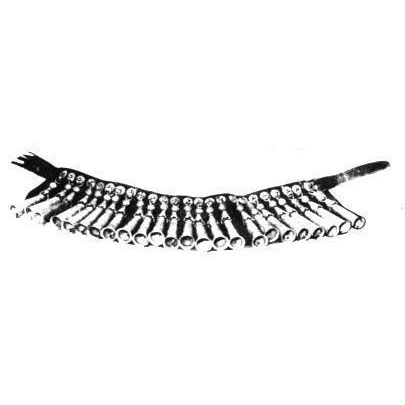waist bell overview
 The waist bell (pinyin: Yāo líng) is also known as the shaman bell in the Manchu language Xisha. It is a mutual-strike body-sounding instrument popular in Heilongjiang, Jilin, Liaoning, Inner Mongolia and other provinces. The body of the bell is made of bronze, in the shape of a spherical shape, with a diameter of 4 cm to 5 cm. The lower end of the bell has a character-shaped sound hole. The hole is 3 cm long and 0.5 cm wide. A few sandstones or iron beads are placed in the bell. The upper end of the bell is provided with a ring, and three to five small bells are connected in series with silk strings or thin leather strips. It is tied to the top of a round wooden stick about 100 cm long.
The waist bell (pinyin: Yāo líng) is also known as the shaman bell in the Manchu language Xisha. It is a mutual-strike body-sounding instrument popular in Heilongjiang, Jilin, Liaoning, Inner Mongolia and other provinces. The body of the bell is made of bronze, in the shape of a spherical shape, with a diameter of 4 cm to 5 cm. The lower end of the bell has a character-shaped sound hole. The hole is 3 cm long and 0.5 cm wide. A few sandstones or iron beads are placed in the bell. The upper end of the bell is provided with a ring, and three to five small bells are connected in series with silk strings or thin leather strips. It is tied to the top of a round wooden stick about 100 cm long.In the Manchu shaman's dance ritual, "the use of drums and waist bells together" is a typical feature of the use of musical instruments. For example, the Manchurian shaman dance god sacrificial utensils contained in the "Hulan Fu Zhi" in Heilongjiang: Hama knife (sacred knife), Hongwu (shaking bell), lifting drum, single-ring drum, tie board, waist bell, skirt, etc. In the shaman dance of the Qing Dynasty, the waist bell is still preserved. As we all know, the ceremonies in the Qing Dynasty mostly followed the Ming ceremony, which was actually the Han system, and "the traditional custom can still be preserved only by offering sacrifices to the heavens at the Tangzi and offering sacrifices to the gods at the Kunning Palace". The musical instruments used by the shamans of the Qing Dynasty to dance the gods have been added to the pipa, sanxian, etc., but the god drum and waist bell have not been lost. Pu Jia, a Manchu nobleman, once described the situation of court shamans using waist bells to dance the gods: "After a while, two 'shaman's wives' came in, wearing embroidered robes, wearing danzi on their heads, and high-soled shoes on their feet, one bouncing up Three strings, another string of copper bells tied around the waist...". These "strings of copper bells" tied around the waist are undoubtedly waist bells.
Several editions of the Manchu Sacrifice to the Gods and Heaven have drawn drawings of the waist bell, and are marked with definite dimensions. During the performance, the waist bell is tied around the waist of the performer. When the waist bell swings, it makes rhythmic sounds, in harmony with the ever-changing sounds of drums and drums. It is one of the main accompaniment instruments in shamanic dance. The main skills are tossing, swinging, pausing, shaking and so on. Waist bells were originally dance implements and musical instruments performed in shamanic sacrificial ceremonies, and were later used by folks to worship heaven and ancestors, burn incense to make a vow, celebrate harvest, festival entertainment and other occasions.
When performing, they hold shamanic drums, tie waist bells, or wear costumes decorated with bronze mirrors or waist bells, and beat, sing and dance while performing. During the dance, various movements such as swaying, swinging, shaking, shaking, shaking, and bumping are used to make the small bells strike each other to make sounds, and the sound is clear and loud. The drums are varied, the tunes are rich, and the dancing is beautiful. Larger performance scenes are also accompanied by musical instruments such as hama knife, charazi, round drum, sanxian and lute. Today's shamanic drums and waist bells are mostly used to accompany folk songs, dances and singing, and sometimes shamanic drums are also used for instrumental ensembles.
- Pinyin:Yāo líng
- nickname:Shaman Bell
- popular area:Heilongjiang, Jilin, Liaoning, Inner Mongolia and other provinces
- type:Mutual sounding instrument
overview of other similar instruments
- sanyanxiao overview
- Daguangxian overview
- Leiqin overview
- hahao overview
- yandundagu overview
- Han Xiaozheng overview
- Fang Xiang overview
- guanzi overview
- zhuqin (Dao Qin) overview
- zhuiqin overview
- bangzi overview
- three-stringed piano overview
- Gehu overview
- xiao overview
- xiaokonghou overview
- Konghou overview
- Sheng overview
- suona overview
- hulusi overview
- gushao overview
 渝公网安备 50010702504639号
渝公网安备 50010702504639号